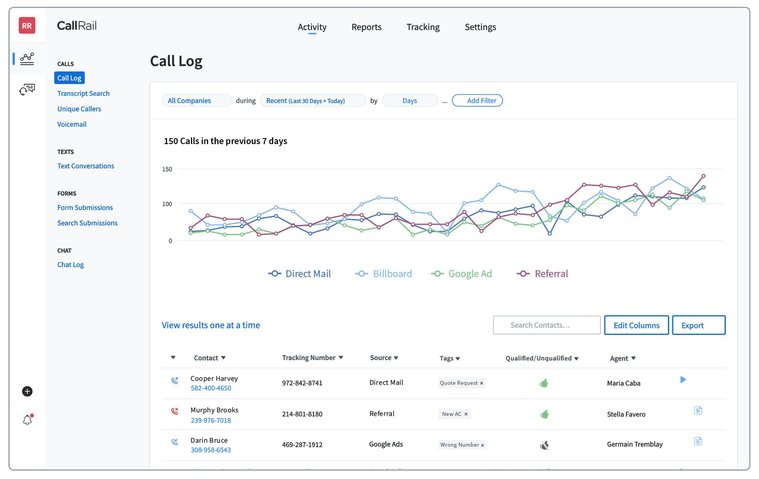Lead tracking is the process of determining the source of leads, actively monitoring where leads are in the sales and marketing funnel, and pursuing the appropriate actions to move the lead to the next stage and close the sale.
Why do sales and marketing need lead tracking?
Lead tracking is a crucial component in the world of sales and marketing. It enables businesses to monitor and analyze the progress of potential clients or customers as they move through the sales funnel. Effective lead tracking helps businesses improve their customer acquisition strategies and tailor the buying experience to individual needs.
Lead tracking helps sales and marketing departments seamlessly work together to find more qualified potential leads and close more sales. Additionally, lead tracking will often help you create a better user experience for your audience.
Effective lead tracking can help marketing departments determine where their leads came from and how those leads reached out or were contacted, which helps marketing teams discover which campaigns are bringing in the most qualified leads. From there, the marketing team can pass qualified leads to their sales department with all the information needed to close the lead and complete the conversion.
Implementing proper lead tracking means that your sales team has all the data they need to customize and individualize their approach for each prospect, making a conversion or sale that much more likely.
This insight allows for informed adjustments to strategies, ultimately increasing the efficiency of lead generation.
Another benefit of lead tracking is its ability to ensure that no potential customer or client falls through the cracks. Sales representatives can follow up on leads promptly and consistently, leading to better conversion rates. Keeping track of every interaction with a lead—be it phone calls, emails, or meetings—allows for timely follow-ups and a more personalized buying experience.
Proper lead tracking involves:
- Identifying and defining the sources of your leads.
- Selecting and evaluating a suitable lead tracking option.
- Implementing a system within your organization.
This process helps streamline workflows, improve communication within the team, and foster collaboration among sales and marketing departments.
Lead tracking plays a vital role in sales and marketing processes. It not only aids in optimizing marketing efforts and strategies but also ensures a personalized and efficient experience for potential customers—resulting in higher conversion rates and business growth.
Different methods of lead tracking

Marketing automation tools
Marketing automation tools provide a systematic approach to tracking and analyzing leads at different customer journey touchpoints. These tools help monitor leads' engagement with marketing campaigns, assist in segmentation, and nurture them through personalized content. CallRail, for example, is one such tool that businesses can use to track various leads, which not only helps in lead management but also improves marketing strategies and efforts. Automation tools make the process more efficient, freeing up valuable time and resources.
Customer relationship management software
Customer Relationship Management (CRM) software is a valuable resource for lead tracking. It centralizes data, allowing marketing and sales teams to understand of all potential customers' activities clearly. CRMs assist in streamlining communication among team members, as well as with leads, by maintaining detailed records of interactions. This comprehensive database allows teams to analyze better, prioritize, and convert leads into customers more effectively.
Spreadsheets
Although manual, spreadsheets can be used for lead tracking when simpler alternatives are needed. A business can create and manage an organized record of their current and potential leads using software like Microsoft Excel or Google Sheets. A key feature of spreadsheets is their ability to accommodate customizable columns and rows that suit specific business requirements, such as lead source, contact information, and engagement level. However, this method requires regular manual input and updates, making it less efficient than marketing automation tools and CRM software.
Types of leads to track
Phone calls
Phone call leads are crucial for businesses that rely on direct communication to engage and convert potential customers. Tracking these leads helps in understanding which marketing channels are most effective in generating calls, allowing businesses to allocate resources wisely. Tools like CallRail can greatly assist in tracking these leads by providing visitor & source tracking, call analytics, and insights, such as call volume, duration, and caller information. Accurate phone call tracking enables businesses to analyze patterns, optimize marketing efforts, and deliver better customer experiences.
Forms
Forms play a significant role in capturing lead information from website visitors interested in a product or service. Tracking form leads is essential for understanding how effectively a website converts visitors into potential customers. By analyzing form submissions, businesses can gauge the impact of their content, design, and user experience on lead generation. They can also assess the efficiency of their nurturing efforts, such as email campaigns or personalized follow-ups, in converting form leads into sales opportunities.
With data from lead tracking tools, businesses can make informed decisions to improve their form designs, content strategies, and overall marketing efforts. Accurate tracking of phone calls and forms leads can lead to higher conversion rates, more sales, and sustained business growth.
Advantages of effective lead tracking
Increased sales
By implementing an effective lead tracking system, businesses can identify which leads have the highest potential of converting into sales. This allows sales teams to prioritize their efforts and allocate resources strategically. As a result, the chances of closing deals increase significantly, leading to higher sales revenue.
Customer retention
Another key advantage of effective lead tracking is its role in customer retention. Understanding the needs and preferences of leads enables businesses to better cater to their requirements, fostering stronger customer relationships. With improved customer satisfaction, there is a higher likelihood of retaining customers, who will continue contributing to the business's revenue.
Maximizing marketing budget
With an optimized lead tracking system, businesses can analyze the performance of their marketing campaigns and identify which channels are generating the highest quality leads. Companies can allocate their marketing budget more efficiently by focusing on these profitable sources. This leads to a better return on investment (ROI), which in turn, contributes to the growth and success of the business.
Effective lead tracking is key to sales growth, customer retention, and maximizing the marketing budget. By implementing a robust lead tracking system, companies can enjoy these benefits and drive their business toward greater success.
Where and how do you capture leads?
Above all other considerations, it’s critical to first know how you’re capturing a lead’s information and where that information is stored. Most organizations capture lead data from a variety of inputs and activities: Trade shows and other in-person engagements, data entered in web forms, and inbound phone calls to the business, to name a few.
Consolidating information from these inputs is critical to this process. Most sales and marketing organizations use CRMs like Salesforce or HubSpot to keep information on their leads and prospects.
How to collect lead information (and what to collect)
By collecting and sorting data on your lead’s identity and needs, you’ll be able to properly track their progress through the sales funnel. You’ll also want some piece of contact information — typically, the prospect’s email address or phone number — so you can follow up with them.
In digital marketing, lead information is primarily collected through web forms. The more information you can collect about your lead, the better, as this can be used to not only further engage them but also to inform future marketing efforts.
As an example, if you can determine that a prospect found their way to your website through a particular campaign or through searching for a specific keyword, you can use this data to build future campaigns or double down on the ones you’re currently running.
If you’re capturing lead information in person — say, at a tradeshow or at your place of work — you may want to use a lead scanner. Or, if you’re capturing lead information over the phone, call tracking software can be extremely helpful.
How do you qualify leads and prospects?
Sales departments use different models to determine the real value of a lead or prospect. IBM developed the BANT model (Budget, Authority, Need, and Timeline) in order to qualify their prospects. However, some thought leaders like Ash Alhashim now claim that the BANT model is outdated:
“The biggest problem with BANT, though, is that it assumes that the customer not only has a budget, a need, and a timeline for evaluating and purchasing software in place: As a prerequisite, it assumes that the customer is aware of the fact that they should be buying a product like yours in the first place.”
The generally accepted sales and marketing lead qualification types include:
- Inquiry: A user whose interaction demonstrates potential interest in your service or product.
- Marketing Qualified Lead (MQL): A lead whose interaction with marketing materials indicates they had the potential to become a closed opportunity.
- Sales Accepted Lead (SAL): This is exactly what it sounds like — an MQL that sales have accepted as a potential lead.
- Sales Qualified Lead (SQL): In theory, sales would use the BANT model (or another standard) to determine if the lead is ready for the next steps in the sales process.
- Closed/Won Opportunity: The lead purchased the product or service.
And according to Marketing Insider CEO Michael Brenner, “An inquiry is a person who has done something to express interest in understanding how to solve a problem… A lead is a qualified business opportunity. The only way to know whether an inquiry is a qualified business opportunity is to ask them.”
This funnel varies for different industries but, in general, requires that sales and marketing closely coordinate their efforts and share vital data about lead status.
So then, how do these two departments work together to bring in inquiries and turn them into closed deals? Lead tracking.
How does lead tracking work?
Modern software and tools allow marketers and sales reps to track where inquiries come from and monitor prospects as they develop into variations of qualified and accepted leads throughout the funnel. Multiple tools often integrate together to make this happen — this includes marketing automation tech, customer relationship, lead management software, and call tracking services). These tools usually track multiple touchpoints across channels, both online and offline.
Each software offers its own way of tracking leads. Many use Javascript and cookies to determine how potential leads interact with your content online while tracking numbers are often used to determine how users interact with offline sales and marketing initiatives.
Why is lead tracking important?
Lead tracking gives marketers the data they need to track how leads contacted them, improve campaigns, personalize their efforts, and increase ROI. Similarly, it gives sales the personalized pain point information per lead that they need to close the deal. In essence, lead tracking is the tool set sales reps and marketers use their jobs more effectively.
SiriusDecisions, a research and advisory company, reported in a recent study that “B2B organizations with tightly aligned marketing and sales achieved 24 percent faster revenue growth and 27 percent faster profit growth over a three-year period.”
Lead tracking can also help fill gaps and blind spots in the marketing and sales processes. An estimated 75 percent of marketers have trouble calculating ROI because they don’t know the end results of their campaigns. Meanwhile, 42 percent of sales reps feel they don’t have enough information before making a call.
For modern digital marketers, lead tracking tools are mission-critical because of how they help bridge this gap between data and communication.
Why call tracking is crucial to lead tracking
Research published by Salesforce shows that 92 percent of all customer interactions happen over the phone. Once the sales team connects with a lead via the phone, call tracking is the obvious continuation of the lead tracking and attribution process.
Tools like CallRail’s call attribution and analytics features provide the data needed by sales and marketing teams to synchronize their efforts and optimize their performance. Call tracking software tells marketers:
- What campaigns drove the most leads to call
- Which keywords to continue to target
- What mediums are reaching the right target audience
Additionally, combining your lead tracking efforts with call analytics data gives sales reps and account executives the upper hand in:
- Knowing which callers are true SQLs through call scoring
- Setting up new sales reps to succeed and continue sales training with call recording
- Faster response times (30 to 50 percent of sales go to the vendor that responds first)
Today, lead tracking is critical to the sales and marketing process. The toolset available to marketing and sales departments means less manual data entry, better attribution models, more intuitive sales processes, and happier customers.
Conclusion
Effectively tracking leads plays a crucial role in optimizing sales and marketing efforts. By closely monitoring prospective clients throughout their customer journey, businesses can refine their marketing strategies, accurately target ideal customer personas, and ultimately increase conversions.









